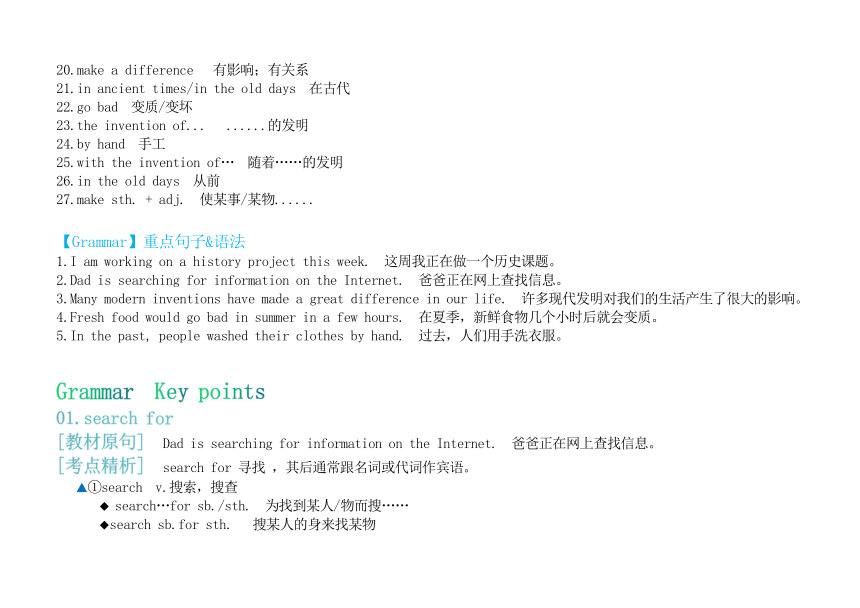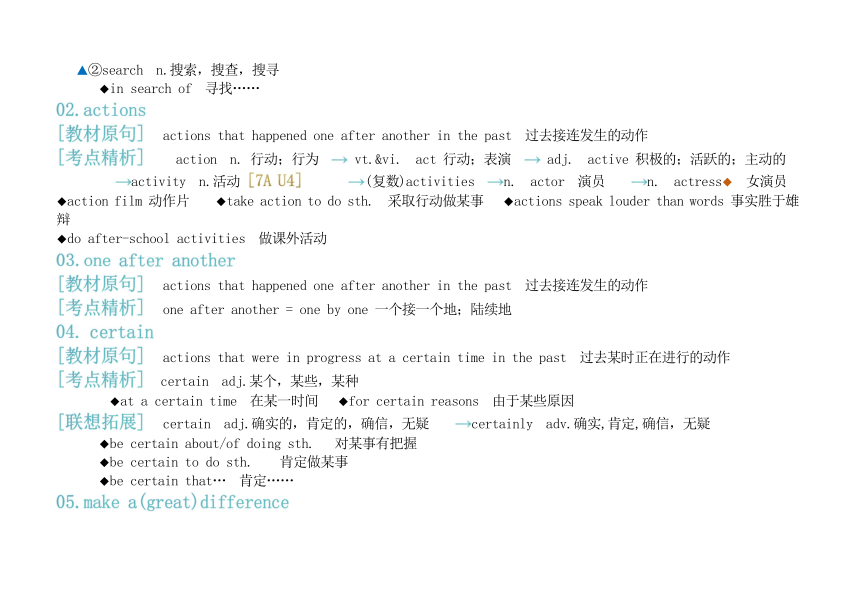Unit 2 Great people—grammar 重要知识点讲义
文档属性
| 名称 | Unit 2 Great people—grammar 重要知识点讲义 |  | |
| 格式 | docx | ||
| 文件大小 | 230.9KB | ||
| 资源类型 | 教案 | ||
| 版本资源 | 牛津译林版 | ||
| 科目 | 英语 | ||
| 更新时间 | 2024-01-07 11:33:38 | ||
图片预览




文档简介
9B U2 Great people
【Grammar】重点单词
1.passage n.章节,乐段
2.by hand 手工
【Grammar】重点短语
1.be used for doing sth. = be used to do sth. 被用于做某事
2.a present taste 现在的状态
3.daily routine and habits 日常生活和习惯
4.one after another = one by one 一个接一个地/相继地;依次地
5.at the moment = right now = now 现在,此刻
6.at the same time = in the meantime = meanwhile 同时
7.present continuous 现在进行时
8.work on 致力于;从事
9.leave for+地点 动身去某地
10.in ancient times 在古代
11.search for information 搜索信息
12.search for 搜索
13.the other day 前几天
14.at a certain time 在某时
15.the whole night = all the night 整晚
16.take part in 参加
17.the day before yesterday 前天
18.have/has been to sp. 去过某地(已回)
19.make a great difference to 产生重大影响
20.make a difference 有影响;有关系
21.in ancient times/in the old days 在古代
22.go bad 变质/变坏
23.the invention of... ......的发明
24.by hand 手工
25.with the invention of… 随着……的发明
26.in the old days 从前
27.make sth. + adj. 使某事/某物......
【Grammar】重点句子&语法
1.I am working on a history project this week. 这周我正在做一个历史课题。
2.Dad is searching for information on the Internet. 爸爸正在网上查找信息。
3.Many modern inventions have made a great difference in our life. 许多现代发明对我们的生活产生了很大的影响。
4.Fresh food would go bad in summer in a few hours. 在夏季,新鲜食物几个小时后就会变质。
5.In the past, people washed their clothes by hand. 过去,人们用手洗衣服。
Grammar Key points
01.search for
[教材原句] Dad is searching for information on the Internet. 爸爸正在网上查找信息。
[考点精析] search for 寻找 ,其后通常跟名词或代词作宾语。
▲①search v.搜索,搜查
◆ search…for sb./sth. 为找到某人/物而搜……
◆search sb.for sth. 搜某人的身来找某物
▲②search n.搜索,搜查,搜寻
◆in search of 寻找……
02.actions
[教材原句] actions that happened one after another in the past 过去接连发生的动作
[考点精析] action n. 行动;行为 → vt.&vi. act 行动;表演 → adj. active 积极的;活跃的;主动的
→activity n.活动 [7A U4] →(复数)activities →n. actor 演员 →n. actress◆ 女演员
◆action film 动作片 ◆take action to do sth. 采取行动做某事 ◆actions speak louder than words 事实胜于雄辩
◆do after-school activities 做课外活动
03.one after another
[教材原句] actions that happened one after another in the past 过去接连发生的动作
[考点精析] one after another = one by one 一个接一个地;陆续地
04. certain
[教材原句] actions that were in progress at a certain time in the past 过去某时正在进行的动作
[考点精析] certain adj.某个,某些,某种
◆at a certain time 在某一时间 ◆for certain reasons 由于某些原因
[联想拓展] certain adj.确实的,肯定的,确信,无疑 →certainly adv.确实,肯定,确信,无疑
◆be certain about/of doing sth. 对某事有把握
◆be certain to do sth. 肯定做某事
◆be certain that… 肯定……
05.make a(great)difference
[教材原句] Many modern inventions have made a great difference in our life. 许多现代发明对我们的生活产生了很大的影响。
[考点精析] make a(great)difference 产生(很大的)影响;有(很大)作用
◆make a difference to sb./sth. 对某人/某物有影响/有作用 ,difference前可加修饰词:big、great,no、much、any等;其中的to是介词,其后可接名词、代词或宾语从句。
★Your age doesn't make any difference to whether you can get the job or not. 你能否得到这份工作与你的年龄无关。
[单选常考混淆辨析]
A.promise B.conversation C.difference D.discussion
06.by hand
[教材原句] In the past,people washed their clothes by hand. 过去,人们用手洗衣服。
[考点精析] by hand 手工 ,by hand 中的by作介词,在此处表示方式或手段。
[联想拓展] by构成的其他常见短语:
◆by bike 骑自行车 ◆by plane/air 乘飞机 ◆by oneself 独自地 ◆by then 到那时
◆by the way 顺便说一句 ◆by the end of 到……为止 ◆by accident/chance 偶然地
【中考重要考点—常见交通方式的表达】
询问交通方式的常用问句: How do/does + sb.+ go/get (to)... “某人如何去.... ”,
表示交通方式的几种表达/常用回答有:
▲①take/drive/ride+冠词/形容词性物主代词+交通工具名词,take+限定词+交通工具名词 =by+交通工具名词
◆take a/(the) taxi/bus/train/ship/plain...
◆drive a/my car
◆ride a bike
▲②by+交通工具名词或交通路线
◆by bike/car/taxi/bus/train/ship/bus/boat/plain/underground/metro/subway...
◆by land/air/ water/sea..
▲③in/on+冠词/形容词性物主代词/指示代词+交通工具名词 = by+交通工具名词
◆in a/one’s car/taxi
◆on a/the bus/train/bike/bicycle/horse/train/ship
注意:◆in 侧重于在里面;◆on 侧重于平面
▲④动词+to+地点名词/动词+地点副词(here/there/home等)
注意: ◆on foot = walk 步行
[联想拓展] by 的其他用法:
易混词汇 词性及含义 用法
by prep. 在…旁边 by the river 在河边
不迟于,在……之前 by June 六月之前
通过…方式 by doing sth. 通过某种方式做某事
Grammar -语法讲解 Grammar:时态精讲
01.时态的概念:
英语中动词的时态是指动作和状态发生的具体时间和表现方式,时态的变化体现在动词上。
02.六大时态:
时态 谓语构成 用法及时间标志词(时间状语)
一般现在时 谓语动词用原形或第三人称单数形式 1.表示现阶段经常性、习惯性的动作或存在的状态; 2.表示客观真理、客观存在或科学事实; 3.用于格言或警句 时间标志词:always,usually,often,sometimes,seldom,never,every day 和 once a month等
一般过去时 谓语动词用过去式 1.表示过去一段时间内习惯性发生或过去经常发生的动作;
2.表示过去发生的动作存在的状态。 时间标志词:yesterday,the day before yesterday,last night/year...,...ago,in 2023,the other day等
一般将来时 will/shall/be going to + 动词原形 1.表示将来某个时间将要发生的动作或存在的状态; 2.表示将来经常或反复发生的动作; 时间标志词:tomorrow,next week/month/year,in the future等
现在进行时 am/is/are + 动词的现在分词 1.表示现在说话时或现阶段正在发生的动作或存在的状态。
2.表示事先安排好的即将发生的动作; 3.表示此时某一动作不断地重复; 时间标志词:at the moment、now 和 right now等, Look!Listen!用于句首,以唤起对方注意时,也常用现在进行时;
现在完成时 have/has + 动词的过去分词 1.表示过去发生或已经完成的动作对现在产生的结果或影响;
2.表示过去发生的动作一直持续到现在,或者可能延续到将来的动作或状态;
3.表示过去某动作到现在已经发生了多少次; 时间标志词:three times ,so far,already,just,up to now,ever,(not)yet,recently,until,till now,since + 时间点,for+时间段等
过去进行时 was/were + 动词的现在分词 1.表示过去某个时刻正在发生的动作;
2.表示过去同一时间里同时发生的动作;
3.表示过去某个时间段内持续发生的动作或存在的状态; 时间标志词:at this time yesterday,then,at that moment,from...to...等
03.易混时态的比较:[常考辨析—1 ] 一般现在时和现在进行时
一般现在时 现在进行时
1.一般现在时表示现在习惯性的/经常重复的/定期发生的动作或存在的状态; 2.或者用于描述客观真理、格言、科学事实; 3.其他不受时间限制的客观存在。 1.现在进行时表示说话时正在进行的动作; 2.目前阶段正在进行的动作或存在的状态。
一般现在时表示一个动作接着一个动作,用来描述连续性的事件 现在进行时表示几个动作同时进行
一般现在时可以用来描述日常生活和习惯 现在进行时可以表示在特定时间段里所发生的动作
一般现在时表示按计划、规定或时间表将要发生的动作 现在进行时表示即将发生的动作或安排: 用于这种情况的动词主要有: go、come、leave、start,arrive、return等。
在while引导的时间状语从句中,通常要用进行时态(现在进行时或过去进行时)
与一般现在时连用的时间状语:always、usually、often、sometimes、seldom、never,every day,once a month、three times a week等 与现在进行时连用的时间状语:at the moment、now、right now,动词如look、listen等单独用于句首以引起对方注意时
现在进行时的特殊用法:现在进行时与always、often、forever等词连用,表示反复发生的动作,常含有说话者的赞扬、厌恶或不满等情绪。
04.易混时态的比较:[常考辨析—2 ] 一般过去时和过去进行时
一般过去时 过去进行时
一般过去时表示过去发生的动作或存在的状态 1.过去进行时表示过去的某个时刻正在发生的动作; 2.过去同一时间里同时发生的动作或在过去的某个时间段内持续发生的动作或存在的状态
常用的时间状语: yesterday、two years ago,last week、in 2000等 常用的时间状语: at this time yesterday、at 6:00 last night等
一般过去时可以表示过去发生的一系列连续的动作 而过去进行时表示过去一个动作发生时,另外一个动作正在进行
05.易混时态的比较:[常考辨析—3 ] when 与 while 牵扯到的一般过去时和过去进行时
when while
when后面既可跟延续性动词,也可跟非延续性动词,常用于一般过去时 while后面一般跟延续性动词,常用于过去进行时
when的意思是“当……时,在……时候” while的意思是“当……的时候,在……期间”
它表示的时间概念比较广泛,不但可以表示具体的时间点,而且也可以表示一段时间。 从while本身的词义来看,它只能表示一段时间,不能表示具体的时间点。
06.易混时态的比较:[常考辨析—4 ] 一般过去时和现在完成时
一般过去时 现在完成时
一般过去时表示过去某时发生的动作或单纯叙述过去发生的事情,强调过去的动作或状态; 现在完成时表示过去发生的动作或事情对现在的影响或产生的结果,强调对现在的影响。
一般过去时表示动作在过去已经停止; 现在完成时表示过去开始的动作一直延续到现在,可能还要延续下去。
一般过去时对动词是延续性或非延续性无明确要求; 现在完成时中有时间状语如“for+时间段”或since出现时,常要将非延续性动词改为延续性动词: die→be dead borrow→keep leave→be away
一般过去时的时间标志词: 常和yesterday、last night/week/year………ago、in 2014、just now等连用 现在完成时的时间标志词: 常和“for+时间段”“since+时间点”以及already,so far、in the past few years等连用
【Grammar】重点单词
1.passage n.章节,乐段
2.by hand 手工
【Grammar】重点短语
1.be used for doing sth. = be used to do sth. 被用于做某事
2.a present taste 现在的状态
3.daily routine and habits 日常生活和习惯
4.one after another = one by one 一个接一个地/相继地;依次地
5.at the moment = right now = now 现在,此刻
6.at the same time = in the meantime = meanwhile 同时
7.present continuous 现在进行时
8.work on 致力于;从事
9.leave for+地点 动身去某地
10.in ancient times 在古代
11.search for information 搜索信息
12.search for 搜索
13.the other day 前几天
14.at a certain time 在某时
15.the whole night = all the night 整晚
16.take part in 参加
17.the day before yesterday 前天
18.have/has been to sp. 去过某地(已回)
19.make a great difference to 产生重大影响
20.make a difference 有影响;有关系
21.in ancient times/in the old days 在古代
22.go bad 变质/变坏
23.the invention of... ......的发明
24.by hand 手工
25.with the invention of… 随着……的发明
26.in the old days 从前
27.make sth. + adj. 使某事/某物......
【Grammar】重点句子&语法
1.I am working on a history project this week. 这周我正在做一个历史课题。
2.Dad is searching for information on the Internet. 爸爸正在网上查找信息。
3.Many modern inventions have made a great difference in our life. 许多现代发明对我们的生活产生了很大的影响。
4.Fresh food would go bad in summer in a few hours. 在夏季,新鲜食物几个小时后就会变质。
5.In the past, people washed their clothes by hand. 过去,人们用手洗衣服。
Grammar Key points
01.search for
[教材原句] Dad is searching for information on the Internet. 爸爸正在网上查找信息。
[考点精析] search for 寻找 ,其后通常跟名词或代词作宾语。
▲①search v.搜索,搜查
◆ search…for sb./sth. 为找到某人/物而搜……
◆search sb.for sth. 搜某人的身来找某物
▲②search n.搜索,搜查,搜寻
◆in search of 寻找……
02.actions
[教材原句] actions that happened one after another in the past 过去接连发生的动作
[考点精析] action n. 行动;行为 → vt.&vi. act 行动;表演 → adj. active 积极的;活跃的;主动的
→activity n.活动 [7A U4] →(复数)activities →n. actor 演员 →n. actress◆ 女演员
◆action film 动作片 ◆take action to do sth. 采取行动做某事 ◆actions speak louder than words 事实胜于雄辩
◆do after-school activities 做课外活动
03.one after another
[教材原句] actions that happened one after another in the past 过去接连发生的动作
[考点精析] one after another = one by one 一个接一个地;陆续地
04. certain
[教材原句] actions that were in progress at a certain time in the past 过去某时正在进行的动作
[考点精析] certain adj.某个,某些,某种
◆at a certain time 在某一时间 ◆for certain reasons 由于某些原因
[联想拓展] certain adj.确实的,肯定的,确信,无疑 →certainly adv.确实,肯定,确信,无疑
◆be certain about/of doing sth. 对某事有把握
◆be certain to do sth. 肯定做某事
◆be certain that… 肯定……
05.make a(great)difference
[教材原句] Many modern inventions have made a great difference in our life. 许多现代发明对我们的生活产生了很大的影响。
[考点精析] make a(great)difference 产生(很大的)影响;有(很大)作用
◆make a difference to sb./sth. 对某人/某物有影响/有作用 ,difference前可加修饰词:big、great,no、much、any等;其中的to是介词,其后可接名词、代词或宾语从句。
★Your age doesn't make any difference to whether you can get the job or not. 你能否得到这份工作与你的年龄无关。
[单选常考混淆辨析]
A.promise B.conversation C.difference D.discussion
06.by hand
[教材原句] In the past,people washed their clothes by hand. 过去,人们用手洗衣服。
[考点精析] by hand 手工 ,by hand 中的by作介词,在此处表示方式或手段。
[联想拓展] by构成的其他常见短语:
◆by bike 骑自行车 ◆by plane/air 乘飞机 ◆by oneself 独自地 ◆by then 到那时
◆by the way 顺便说一句 ◆by the end of 到……为止 ◆by accident/chance 偶然地
【中考重要考点—常见交通方式的表达】
询问交通方式的常用问句: How do/does + sb.+ go/get (to)... “某人如何去.... ”,
表示交通方式的几种表达/常用回答有:
▲①take/drive/ride+冠词/形容词性物主代词+交通工具名词,take+限定词+交通工具名词 =by+交通工具名词
◆take a/(the) taxi/bus/train/ship/plain...
◆drive a/my car
◆ride a bike
▲②by+交通工具名词或交通路线
◆by bike/car/taxi/bus/train/ship/bus/boat/plain/underground/metro/subway...
◆by land/air/ water/sea..
▲③in/on+冠词/形容词性物主代词/指示代词+交通工具名词 = by+交通工具名词
◆in a/one’s car/taxi
◆on a/the bus/train/bike/bicycle/horse/train/ship
注意:◆in 侧重于在里面;◆on 侧重于平面
▲④动词+to+地点名词/动词+地点副词(here/there/home等)
注意: ◆on foot = walk 步行
[联想拓展] by 的其他用法:
易混词汇 词性及含义 用法
by prep. 在…旁边 by the river 在河边
不迟于,在……之前 by June 六月之前
通过…方式 by doing sth. 通过某种方式做某事
Grammar -语法讲解 Grammar:时态精讲
01.时态的概念:
英语中动词的时态是指动作和状态发生的具体时间和表现方式,时态的变化体现在动词上。
02.六大时态:
时态 谓语构成 用法及时间标志词(时间状语)
一般现在时 谓语动词用原形或第三人称单数形式 1.表示现阶段经常性、习惯性的动作或存在的状态; 2.表示客观真理、客观存在或科学事实; 3.用于格言或警句 时间标志词:always,usually,often,sometimes,seldom,never,every day 和 once a month等
一般过去时 谓语动词用过去式 1.表示过去一段时间内习惯性发生或过去经常发生的动作;
2.表示过去发生的动作存在的状态。 时间标志词:yesterday,the day before yesterday,last night/year...,...ago,in 2023,the other day等
一般将来时 will/shall/be going to + 动词原形 1.表示将来某个时间将要发生的动作或存在的状态; 2.表示将来经常或反复发生的动作; 时间标志词:tomorrow,next week/month/year,in the future等
现在进行时 am/is/are + 动词的现在分词 1.表示现在说话时或现阶段正在发生的动作或存在的状态。
2.表示事先安排好的即将发生的动作; 3.表示此时某一动作不断地重复; 时间标志词:at the moment、now 和 right now等, Look!Listen!用于句首,以唤起对方注意时,也常用现在进行时;
现在完成时 have/has + 动词的过去分词 1.表示过去发生或已经完成的动作对现在产生的结果或影响;
2.表示过去发生的动作一直持续到现在,或者可能延续到将来的动作或状态;
3.表示过去某动作到现在已经发生了多少次; 时间标志词:three times ,so far,already,just,up to now,ever,(not)yet,recently,until,till now,since + 时间点,for+时间段等
过去进行时 was/were + 动词的现在分词 1.表示过去某个时刻正在发生的动作;
2.表示过去同一时间里同时发生的动作;
3.表示过去某个时间段内持续发生的动作或存在的状态; 时间标志词:at this time yesterday,then,at that moment,from...to...等
03.易混时态的比较:[常考辨析—1 ] 一般现在时和现在进行时
一般现在时 现在进行时
1.一般现在时表示现在习惯性的/经常重复的/定期发生的动作或存在的状态; 2.或者用于描述客观真理、格言、科学事实; 3.其他不受时间限制的客观存在。 1.现在进行时表示说话时正在进行的动作; 2.目前阶段正在进行的动作或存在的状态。
一般现在时表示一个动作接着一个动作,用来描述连续性的事件 现在进行时表示几个动作同时进行
一般现在时可以用来描述日常生活和习惯 现在进行时可以表示在特定时间段里所发生的动作
一般现在时表示按计划、规定或时间表将要发生的动作 现在进行时表示即将发生的动作或安排: 用于这种情况的动词主要有: go、come、leave、start,arrive、return等。
在while引导的时间状语从句中,通常要用进行时态(现在进行时或过去进行时)
与一般现在时连用的时间状语:always、usually、often、sometimes、seldom、never,every day,once a month、three times a week等 与现在进行时连用的时间状语:at the moment、now、right now,动词如look、listen等单独用于句首以引起对方注意时
现在进行时的特殊用法:现在进行时与always、often、forever等词连用,表示反复发生的动作,常含有说话者的赞扬、厌恶或不满等情绪。
04.易混时态的比较:[常考辨析—2 ] 一般过去时和过去进行时
一般过去时 过去进行时
一般过去时表示过去发生的动作或存在的状态 1.过去进行时表示过去的某个时刻正在发生的动作; 2.过去同一时间里同时发生的动作或在过去的某个时间段内持续发生的动作或存在的状态
常用的时间状语: yesterday、two years ago,last week、in 2000等 常用的时间状语: at this time yesterday、at 6:00 last night等
一般过去时可以表示过去发生的一系列连续的动作 而过去进行时表示过去一个动作发生时,另外一个动作正在进行
05.易混时态的比较:[常考辨析—3 ] when 与 while 牵扯到的一般过去时和过去进行时
when while
when后面既可跟延续性动词,也可跟非延续性动词,常用于一般过去时 while后面一般跟延续性动词,常用于过去进行时
when的意思是“当……时,在……时候” while的意思是“当……的时候,在……期间”
它表示的时间概念比较广泛,不但可以表示具体的时间点,而且也可以表示一段时间。 从while本身的词义来看,它只能表示一段时间,不能表示具体的时间点。
06.易混时态的比较:[常考辨析—4 ] 一般过去时和现在完成时
一般过去时 现在完成时
一般过去时表示过去某时发生的动作或单纯叙述过去发生的事情,强调过去的动作或状态; 现在完成时表示过去发生的动作或事情对现在的影响或产生的结果,强调对现在的影响。
一般过去时表示动作在过去已经停止; 现在完成时表示过去开始的动作一直延续到现在,可能还要延续下去。
一般过去时对动词是延续性或非延续性无明确要求; 现在完成时中有时间状语如“for+时间段”或since出现时,常要将非延续性动词改为延续性动词: die→be dead borrow→keep leave→be away
一般过去时的时间标志词: 常和yesterday、last night/week/year………ago、in 2014、just now等连用 现在完成时的时间标志词: 常和“for+时间段”“since+时间点”以及already,so far、in the past few years等连用
